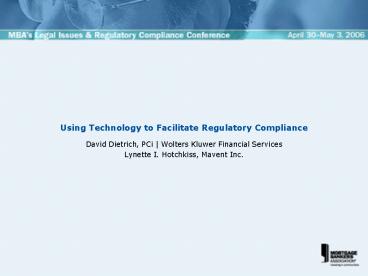Using Technology to Facilitate Regulatory Compliance - PowerPoint PPT Presentation
1 / 19
Title:
Using Technology to Facilitate Regulatory Compliance
Description:
Front-end Fair Lending Management. Address potential violations before they enter the portfolio ... Reduce fair lending training for front-end staff ... – PowerPoint PPT presentation
Number of Views:104
Avg rating:3.0/5.0
Title: Using Technology to Facilitate Regulatory Compliance
1
Using Technology to Facilitate Regulatory
Compliance
- David Dietrich, PCi Wolters Kluwer Financial
Services - Lynette I. Hotchkiss, Mavent Inc.
2
Agenda
- Compliance Issues and Challenges
- HMDA
- Fair Lending
- Enterprise Compliance Management
- TILA/RESPA
- State Law Compliance
- Federal, State, and Local High Cost Laws
3
Compliance Issues and Challenges
- Issues
- Compliance becomes more complex each year
- Acquisitions create multiple technologies and
LOSs - Regulators are demanding higher quality data
- Challenges
- The time and expense of data clean-up operations
- The efficacy of implementing compliance policies
with front line
4
Fragmented Relationship
5
Current Compliance Checkpoints
- Training
- Processes
- Policies
- Procedures
- Some Automation
- Documents
- Paper trail
- Second Review
- Internal and External Audits
- Business line compliance personnel
- Consultants
- Regulatory examinations
6
Current Issues
- HMDA Reg C Submission Requirements
- Must submit APR and yield spread premiums for
mortgages - Need to understand the data, control perception
- Flattening Yield Curve
- Managing Broker Risk
- Several high profile and costly lawsuits
- Going after banks and mortgage companies instead
of brokers and dealers that are actually making
decisions - Very difficult to monitor
7
How to Manage Risk?
- Interviews with sales and underwriting, and
mystery shopping help identify overt
discrimination. - Comparative file review and regression analysis
will identify disparate treatment. - Comparative file review is the most common type
of self-assessment. Expensive and time
consuming. Usually done with a sample of loans. - Regression analysis is the best way to find
disparate impact. - In-house statisticians or outsourced to
consultants. Results can be confusing.
8
The Vision
Integrate and automate compliance throughout the
lending cycle
- Significantly reduce overall cost of compliance
- Greatly reduce effort involved in cleaning data
- Achieve willing support from front-line
operations - Institute stronger controls pre post-closing
9
(No Transcript)
10
Pre-Close Monitoring
11
Front-end Fair Lending Management
- Address potential violations before they enter
the portfolio - Determine in real-time if an applicant was denied
who should have been approved - Prevent an applicant from being overcharged
- Ensure that loans booked do not contain disparate
treatment issues - Integrates with existing LOS integration no drag
on sales - Reduce fair lending training for front-end staff
- Use regression models from Fair Lending Wiz or
custom
12
Post-Closing Monitoring
- Automated Comparative File Review
- Quickly find similar applicants who were treated
differently - Review single or combined portfolios
- Use fewer resources to perform audits
- Focus on high-risk applications and products
- Regression Analysis
- Quickly identify disparate impact and disparate
treatment - Confirm factors that contribute to a lending
decision - No need for extensive knowledge of statistics
- Focus self-assessments and audits on area of risk
13
How Documentation Systems Can HelpTILA/RESPA/Stat
e Law Compliance
- Prepare Accurate TILA Disclosures
- Truth in Lending Disclosure Statement
- Notice of Right to Cancel
- Prepare Accurate GFE/HUD-1
- State Compliance Issues
- Late Charge Provisions
- NSF Provisions
- Prepayment Penalty Provisions
- Correct Documents and Notices
- Texas Designation of Homestead
- Co-signer Notices
- Special Hazard Insurance Disclosures
- Awareness of compliance issues through checklists
or alerts
14
How Automated Compliance Systems Can HelpTILA
RESPA
- Truth in Lending Validation
- APR Accuracy
- Finance Charge Accuracy
- Payment Schedule Calculation
- Right of Rescission Timing
- RESPA
- Escrow Cushion Requirements
- Aggregate Adjustment Calculations
15
How Automated Compliance Systems Can HelpState
Law Compliance
- State Law Compliance Requirements for
- License Review and Validation for Lenders and
Brokers - Fee Limitations/Prohibitions
- Late Charges
- Prepayment Penalties
- Interest Related Issues
- Usury Ceilings
- Calculation Restrictions
- Interest Accrual
- State Specific MI Drop-off
- State Escrow Cushions
16
How Automated Compliance Systems Can
HelpFederal, State, and Local High Cost Laws
- HOEPA
- Threshold Tests
- Prohibited Practices if thresholds triggered
- State Predatory Lending Laws
- Threshold Test based on unique state definitions
- Prohibited Practices if thresholds triggered
- County and Municipal Ordinances
- Combination of Geocoding and Address to make sure
correct local law is applied - Threshold Test based on unique definitions within
ordinances - Prohibited Practices if thresholds triggered
17
Benefits of Using Technology in Regulatory
Compliance
- Uniformity and Consistency for All Loans
- Automate labor-intensive tasks
- Identify issues upstream to reduce costs
downstream - Covers 100 of Loans
- Expert Minds at Work
- Computers Have Good Memories
18
The Vision
Integrate and automate compliance throughout the
lending cycle
- Significantly reduce overall cost of compliance
- Greatly reduce effort involved in cleaning data
- Achieve willing support from front-line
operations - Institute stronger controls pre post-closing
19
Q A































